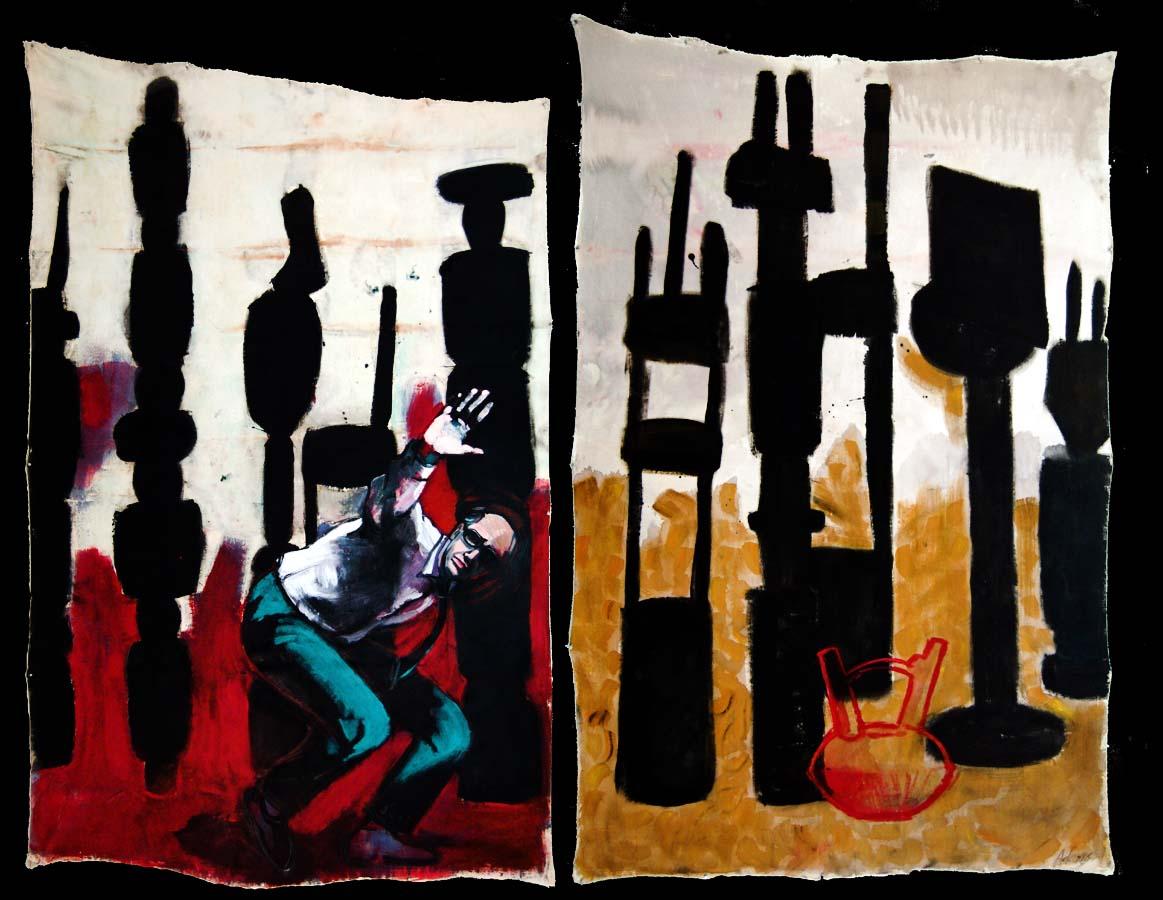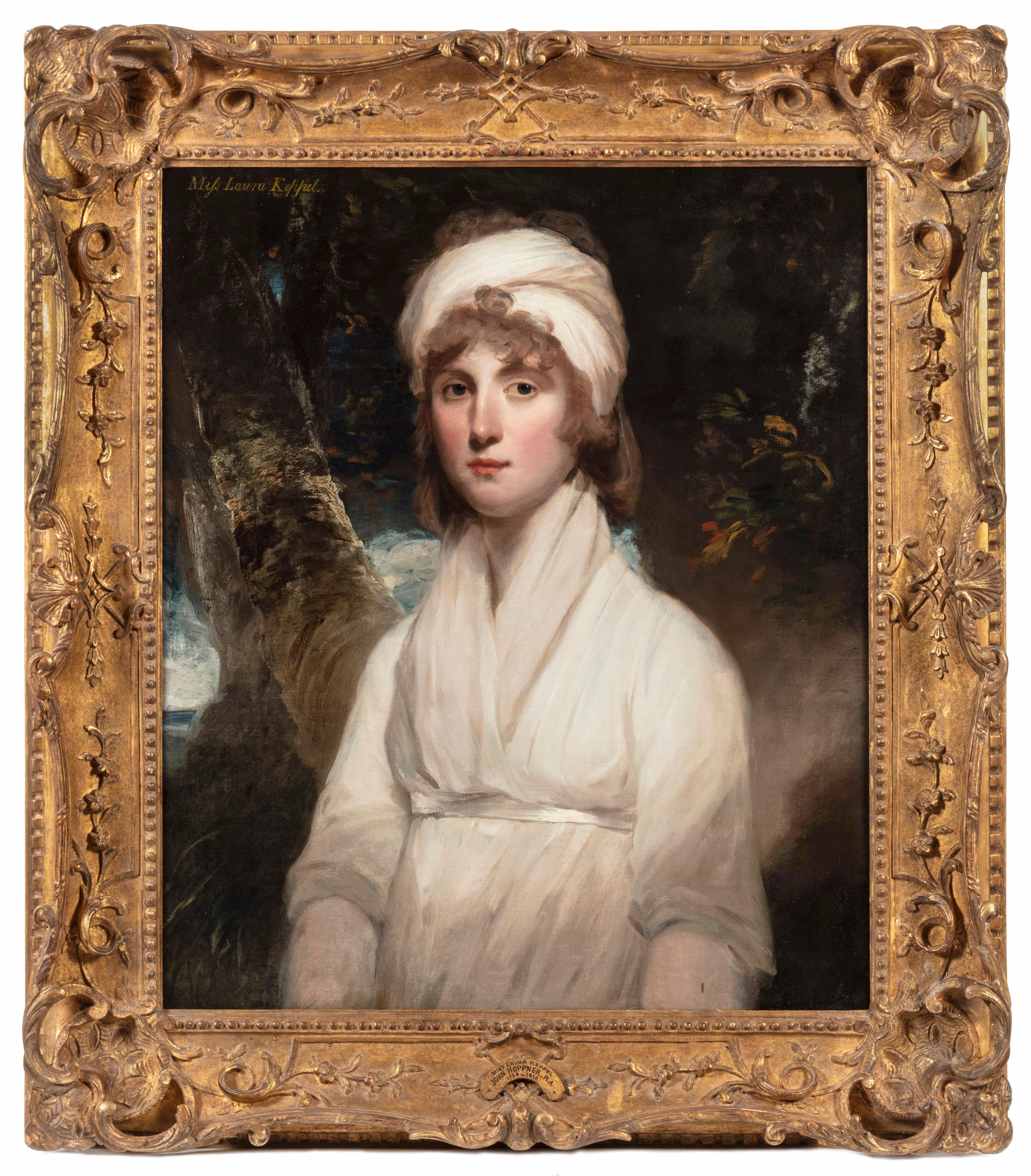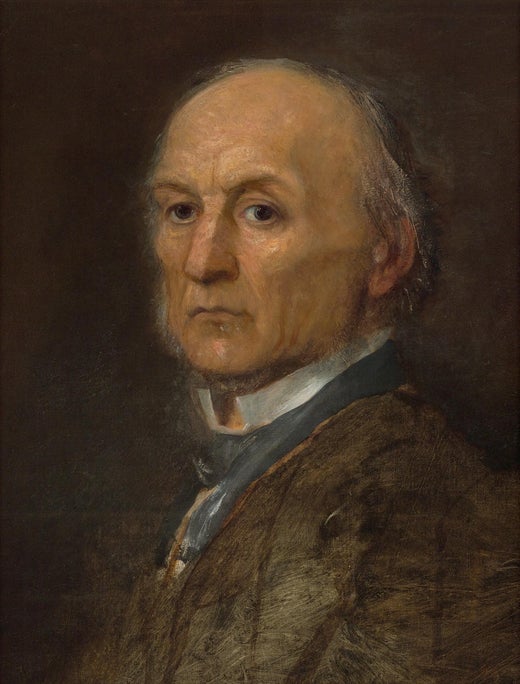Items Similar to Portrait Of Prime Minister William Ewart Gladstone By George Frederic Watts
Want more images or videos?
Request additional images or videos from the seller
1 of 8
George Frederic WattsPortrait Of Prime Minister William Ewart Gladstone By George Frederic Watts1867
1867
About the Item
George Frederic Watts
1817-1904 British
Portrait of Prime Minister William Ewart Gladstone
Oil on canvas
This exceptional portrait captures the stately likeness of the famed “Grand Old Man” of British politics, Prime Minister William Ewart Gladstone. Painted by one of the most important artists of the Victorian era, George Frederic Watts, this portrait of Gladstone captures the commanding presence of this legendary giant at a pivotal point in his long career.
This handsome portrait is the second that Watts made of Gladstone, the first being a striking 1859 portrayal of a younger Gladstone freshly embarking on his political career. It was later gifted directly to the National Portrait Gallery in 1898. Painted almost two decades later in 1876, our portrait depicts an aged and wisened Gladstone at the peak of his career. This portrait was rendered just a few years before his landslide 1800 win that earned him his second term as Prime Minister. Gladstone would remarkably ascend to serve four separate terms as Prime Minister— the most non-consecutive terms of any Prime Minister in British history.
Next to Watts’ earlier portrait, this Gladstone of the late 1870s commands the room with a shrewd expression of stately sagacity. His highly expressive likeness was notoriously difficult to capture in paint, though this did not prevent the immensely popular statesman from posing for countless portraits throughout his life. As the leader of his party for many decades, Gladstone inspired widespread popular devotion. Today, Gladstone’s portraits are in the collections of museums worldwide, including the British Museum and the Getty, with many residing in London’s National Portrait Gallery alone.
Gladstone and Watts found kinship during their portrait sitting, and their endless conversations ultimately delayed the completion of this portrait. Though Watts ceased working on the painting in 1880, he nonetheless fully captured Gladstone’s imposing likeness that stands as a testament to his indelible mark on British history. As an artist, George Frederic Watts was one of the most famous painters and sculptors of the Symbolist movement in Britain, receiving the Order of Merit from Queen Victoria in 1902. His works are in prestigious museum collections such as the Tate, the Metropolitan Museum of Art, the British Museum, and many others.
Watts once said, “I paint ideas, not things,” a captivating concept that imbues this poignant portrait of Gladstone with the monumental weight of his transformative political career.
Painted 1867
Canvas: 20 1/2" high x 16 1/2" wide (52.07 x 41.91 cm)
Frame: 25" high x 20 1/2" wide x 2 1/2" deep (63.50 x 52.07 x 6.35 cm)
Provenance:
Collection of the artist
Collection of the artist’s widow, Mary Watts
Collection of Lillian Chapman
Private Collection, London
M.S. Rau, New Orleans
Literature:
M.S. Watts, George Frederick Watts: Annals Of An Artist's Life, vols. I and II, 1912
- Creator:George Frederic Watts (1817 - 1904, British)
- Creation Year:1867
- Dimensions:Height: 25 in (63.5 cm)Width: 20.5 in (52.07 cm)Depth: 2.5 in (6.35 cm)
- Medium:
- Period:
- Condition:
- Gallery Location:New Orleans, LA
- Reference Number:
George Frederic Watts
George Frederic Watts OM, RA (1817 – 1904) was considered one of the greatest artists of the Victorian era, internationally renowned and celebrated in his own lifetime. He pursued an individual artistic approach and is remembered most for his large-scale symbolist paintings reflecting Victorian sensibilities and Hall of Fame portraits, capturing his distinguished contemporaries in Victorian society. In artistic terms he is significant not only because of the works he produced, but because of his determined innovation in developing an artistic practice which was not tied to a larger artistic movement. A portraitist, sculptor, landscape painter and symbolist, Watts's work embodied the most pressing themes and ideas of the time, earning him the title England's Michelangelo.
About the Seller
5.0
Vetted Seller
These experienced sellers undergo a comprehensive evaluation by our team of in-house experts.
Established in 1912
1stDibs seller since 2013
15 sales on 1stDibs
Typical response time: 4 hours
- ShippingRetrieving quote...Ships From: New Orleans, LA
- Return PolicyThis item cannot be returned.
More From This SellerView All
- Portrait of Napoléon IILocated in New Orleans, LAThe son of the legendary Napoléon Bonaparte, Napoléon François Charles Joseph, takes a spirited stance in this remarkable oil painting attributed to the Austrian portraitist Johann Peter Krafft. Believed to have been exhibited at the Exposition Universelle of 1900 in Paris, this work stands as a testament to both Austrian artistry and the legacy of one of the most powerful men in history. After Napoléon's exile to the island of Elba in 1814, his son was seen by many of his supporters as the last hope of France. The child was named the ruler of half of Europe, holding the titles of Napoléon II...Category
Early 19th Century Academic Portrait Paintings
MaterialsCanvas, Oil
- Madonna Addolorata By SassoferratoBy Giovanni Battista Salvi da SassoferratoLocated in New Orleans, LASassoferrato (Giovanni Battista Salvi) 1609-1685 Italian Madonna Addolorata Oil on canvas Celebrated Italian artist Sassoferrato and his moving religious imagery are the epitome ...Category
17th Century Baroque Figurative Paintings
MaterialsCanvas, Oil
- Gum KidsBy Leslie ThrasherLocated in New Orleans, LATwo young children play an ill-advised game of gum stretching on the family couch in this charming composition by famed American illustrator, Leslie Thrasher. Painted towards the start of the Great Depression, Thrasher provided light-hearted images of the lives of everyday people to distract Americans from their troubles. These images appeared on the covers of Liberty Magazine, for whom he produced one cover illustration a week for six consecutive years. Born in 1889 in Piedmont, West Virginia, Thrasher studied at the Pennsylvania Academy of Fine Arts as a teenager and received a scholarship to study art abroad in Paris. Upon his return, he began studying under Howard Pyle, known as the “father of American illustration.” Thrasher sold his first cover illustration to the Saturday Evening Post in 1912, four years before Norman Rockwell’s first Post cover, and he would go on to produce over 360 magazine covers throughout his career. He painted humorous, relatable scenes of life in America with colorful characters set against white backgrounds. He was also a successful commercial artist, painting advertisements for Cream of Wheat, Chesterfield Cigarettes...Category
20th Century Other Art Style Figurative Paintings
MaterialsOil, Canvas
- Cytheris by John Wiliam GodwardBy John William GodwardLocated in New Orleans, LAJohn William Godward 1861-1922 British Cytheris Signed and dated "J.W. Godward / 1922" (upper left) Oil on canvas A classical beauty is captured in a moment of idle reflection in this stunning oil on canvas by John William Godward. Celebrated as one of the most important classical painters at the turn of the century, Godward's career was devoted to a segment of Classicism known as the Marble School, with Greco-Roman subjects placed within architectural settings. His elegant subjects are depicted with a degree of sensuality and technical mastery that remains unsurpassed. The present work, entitled Cytheris, embodies Godward’s lifelong preoccupation with depicting beautiful young women in classically-inspired dress. Cytheris is a nickname associated with Aphrodite, the goddess of love, who was said to have been born of the waves off the coast of the Greek island Cytherea. The title points to the sitter's beauty, but also, as Godward scholar Vern Swanson suggests, perhaps indicates she is a priestess of the cult of Aphrodite, while her soft blue head covering and downward gaze convey a virginal quality. Beautifully rendered with Godward's signature technical perfection, the piece embodies the sensual, graceful languor that permeates his greatest works. Raised in Wimbledon, England, Godward debuted at London’s Royal Academy exhibition in 1887. By the subsequent decade, the burgeoning artist was on a steady ascent to artistic success. Having fallen under the influence of British Neoclassical Revivalists Sir Lawrence Alma-Tadema, Lord Frederic Leighton, and Sir Edward John Poynter, Godward quickly adopted, if not rivaled, their style. He envisioned similar scenes of the ancient world, seamlessly blending antiquity and beauty in breathtaking compositions. The sensuality and mystery of Godward’s maidens, combined with his impressive antique backdrops...Category
20th Century Portrait Paintings
MaterialsOil, Canvas
- Portrait of a Beauty by William Clarke WontnerBy William Clarke WontnerLocated in New Orleans, LAWilliam Clarke Wontner 1857-1930 British Portrait of a Beauty Signed and dated "W. Wontner 1918" (lower left) Oil on canvas Classical beauty a...Category
20th Century Portrait Paintings
MaterialsOil, Canvas
- At the MirrorBy Frederick Carl FriesekeLocated in New Orleans, LAthe most important American Impressionists of his age. While many of his contemporaries focused on the landscape, Frieseke gained his inspiration from the figural, and in particular the theme of femininity. His works capture female figures engaging in traditionally feminine roles — strolling in the garden or posed in a domestic interior. At the Mirror...Category
Early 20th Century Impressionist Nude Paintings
MaterialsOil, Canvas
You May Also Like
- Island of Broken Toys (diptych)Located in Burlingame, CA'Island of Broken Toys' 2019, a diptych contemporary oil on canvas painting by Tamera Avery, whose paintings are created with wit and wisdom. Avery's work...Category
21st Century and Contemporary Contemporary Portrait Paintings
MaterialsCotton Canvas, Oil
- Oil Painting / Photorealism / Figurative Art / Human Figure /MuseumBy Bruce AdamsLocated in Buffalo, NYBruce Adams was a painter, art educator, and writer. Born in Buffalo, N.Y., in 1952, he received a B.S. in 1976 and an M.A. in 1983 from Buffalo State College. Adams’s work is includ...Category
1980s Contemporary Figurative Paintings
MaterialsCanvas, Oil
- Madonna and Child with Angels in the CloudsLocated in New York, NYProvenance: Charles H. and Virginia Baldwin, Claremont, Colorado Springs, Colorado ca. 1907-1934; thence by descent until sold in 1949 to: Charles Blevins Davis, Claremont (renamed Trianon), Colorado Springs 1949 -until gifted in 1952 to: The Poor Sisters of Saint Francis, Trianon, Colorado Springs, 1952 until acquired, 1960, by: John W. Metzger, Trianon, renamed as the Trianon School of Fine Arts, Colorado Springs, 1960-1967; when transferred to: The Metzger Family Foundation, Trianon Art Museum, Denver, 1967 - 2004; thence by descent in the Metzger Family until 2015 Exhibited: Trianon Art Museum, Denver (until 2004) The present work is a spectacular jewel-like canvas by Amigoni, rich in delicate pastel colors, most likely a modello for an altarpiece either lost or never painted. In it the Madonna stands firmly upon a cloud in the heavens, her Child resting on a delicate veil further supported by a cloud, as he gently wraps his arm around his mother’s neck. From above angels prepare to lower flowers and a wreath, while other angels and seraphim surrounding the two joyfully cavort. Dr. Annalisa Scarpa, author of the forthcoming monograph on Jacopo Amigoni...Category
18th Century and Earlier Figurative Paintings
MaterialsCanvas, Oil
- Portrait of Laura Keppel, later Lady SouthamptonBy Sir John HoppnerLocated in New York, NYInscribed, upper left: “Miss Laura Keppel” Provenance: Commissioned from the artist and by descent in the Keppel family estate, Lexham Hall, Norfolk, to: Major Bertram William Arnol...Category
18th Century Paintings
MaterialsCanvas, Oil
- Portrait of a Lady with a ChiqueadorLocated in New York, NYProvenance: Torres Family Collection, Asunción, Paraguay, ca. 1967-2017 While the genre of portraiture flourished in the New World, very few examples of early Spanish colonial portraits have survived to the present day. This remarkable painting is a rare example of female portraiture, depicting a member of the highest echelons of society in Cuzco during the last quarter of the 17th century. Its most distinctive feature is the false beauty mark (called a chiqueador) that the sitter wears on her left temple. Chiqueadores served both a cosmetic and medicinal function. In addition to beautifying their wearers, these silk or velvet pouches often contained medicinal herbs thought to cure headaches. This painting depicts an unidentified lady from the Creole elite in Cuzco. Her formal posture and black costume are both typical of the established conventions of period portraiture and in line with the severe fashion of the Spanish court under the reign of Charles II, which remained current until the 18th century. She is shown in three-quarter profile, her long braids tied with soft pink bows and decorated with quatrefoil flowers, likely made of silver. Her facial features are idealized and rendered with great subtly, particularly in the rosy cheeks. While this portrait lacks the conventional coat of arms or cartouche that identifies the sitter, her high status is made clear by the wealth of jewels and luxury materials present in the painting. She is placed in an interior, set off against the red velvet curtain tied in the middle with a knot on her right, and the table covered with gold-trimmed red velvet cloth at the left. The sitter wears a four-tier pearl necklace with a knot in the center with matching three-tiered pearl bracelets and a cross-shaped earing with three increasingly large pearls. She also has several gold and silver rings on both hands—one holds a pair of silver gloves with red lining and the other is posed on a golden metal box, possibly a jewelry box. The materials of her costume are also of the highest quality, particularly the white lace trim of her wide neckline and circular cuffs. The historical moment in which this painting was produced was particularly rich in commissions of this kind. Following his arrival in Cuzco from Spain in the early 1670’s, bishop Manuel de Mollinedo y Angulo actively promoted the emergence of a distinctive regional school of painting in the city. Additionally, with the increase of wealth and economic prosperity in the New World, portraits quickly became a way for the growing elite class to celebrate their place in society and to preserve their memory. Portraits like this one would have been prominently displayed in a family’s home, perhaps in a dynastic portrait gallery. We are grateful to Professor Luis Eduardo Wuffarden for his assistance cataloguing this painting on the basis of high-resolution images. He has written that “the sober palette of the canvas, the quality of the pigments, the degree of aging, and the craquelure pattern on the painting layer confirm it to be an authentic and representative work of the Cuzco school of painting...Category
17th Century Old Masters Paintings
MaterialsCanvas, Oil
- Men portraitBy Giovanni Maria delle Piane dit Mulinaretto (Genoa 1670 - Monticelli d´Ongina 1745)Located in BELEYMAS, FRGiovanni Maria DELLE PIANE, known as IL MULINARETTO (Genoa, 1660 – Monticelli d'Ongina, 1745) Portrait of a man Oil on oval canvas H. 108 cm; L. 83 cm Provenance: Nino Ferrari Colle...Category
1730s Italian School Figurative Paintings
MaterialsCanvas, Oil
Recently Viewed
View AllRead More
Wear Louis Comfort Tiffany’s Genius on Your Finger with This Vivid Ring
In his jewelry making, the designer rarely used diamonds — this rare example has two.
You Won’t Find a More Handsome Stopwatch Than This 1890s Pocket Chronograph
A Grand Complication from the golden era of pocket watches, the Marius Lecoultre pocket watch does everything but uncork your wine.
More Ways To Browse
Watters And Watters
By Watts Art
Monumental Portrait
Portrait Of An Old Man
Prime Minister
George Tate
Monumental Painting Antique
The Om
Queen Victoria Painting
Monumental Antique Oil Painting
Oil Late 1800s
George Frederic
Queen Mary Portrait
Watting William
Late 1800s Oil Painting
Queen Mary I
Sitting Room Painting
Getty Oil






